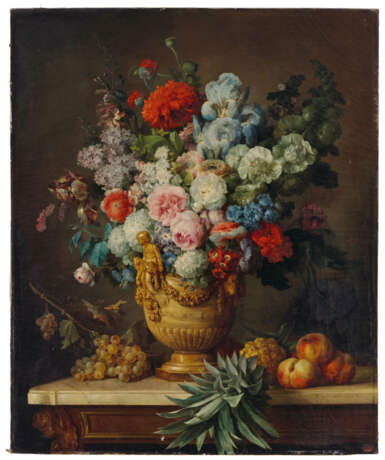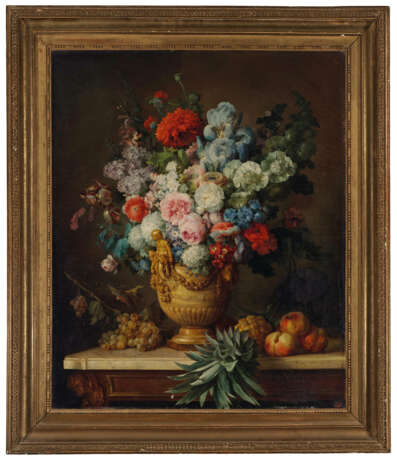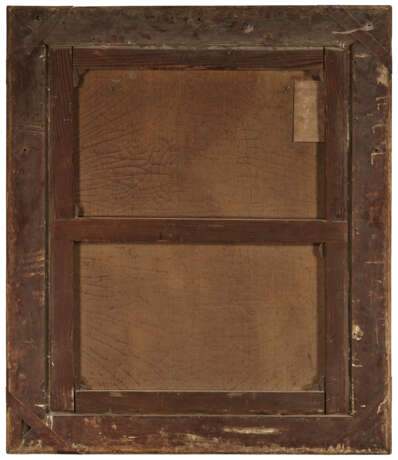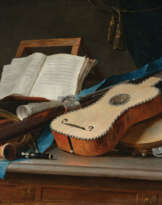ID 974898
Lot 42 | ANNE VALLAYER-COSTER (PARIS 1744-1818)
Valeur estimée
€ 600 000 – 1 000 000
Nature morte au vase d’albâtre rempli de fleurs avec sur une table plusieurs espèces de fruits, comme ananas, pêches et raisins
signé et daté 'M Ver. Coster. 1783.' (en bas, à droite, sur la plaque de marbre)
huile sur toile, sur sa toile d'origine
108,5 x 89,5 cm. (42 3/4 x 35 1/4 in.)
dans un cadre en bois sculpté doré estampillé 'E. L. INFROIT', avec la Jurande des Menuisiers Ébénistes
probablement dans son cadre d'origine, avec des modifications apportées dans la première partie du XIXe siècle
Provenance
Collection de l'artiste ; sa vente, 21 juin 1824, lot 1 (vendu 1,100 F à un Coster) - le catalogue de vente spécifie qu'il s'agit d' 'Un des ouvrages les plus capitaux de cette célèbre artiste, il offre, pour objet principal, un vase d'albâtre richement orné, dans lequel sont placées des fleurs du plus bel éclat et du plus beau choix. Ce vase, posé sur une table à dessus de marbre blanc, est entouré de fruits, tels que grapes de raisin, pêches et ananas. Il porte la date de 1783 ; et, depuis cette époque, qui était celle de la grande force des talens [sic] de Mme Coster, elle a constamment résisté aux instances réitérées des personnages illustres et des amateurs distingués qui désiraient posséder ce tableau, dont elle n'a jamais voulu se désaisir, le regardant comme le meilleur de ses ouvrages' ; puis très probablement resté dans la descendance.
Acquis par le père de l'actuel propriétaire dans la région de Nomexy dans la seconde moitié des années 1940.
Literature
Anonyme, Mercure de France : dédié au Roy, 20 septembre 1783, p. 130.
Anonyme, Journal de Paris, 20 septembre 1783, 263, p. 1086.
Anonyme, Le Sallon à l'encan, Rêve pittoresque, mêlé de Vaudevilles, Paris, 1783, p. 26.
Anonyme, Apelle au Sallon, Paris, 1783, p. 24.
Anonyme, Changez-moi cette tête, ou Lustucru au Sallon. Dialogue entre le Duc de Marlborough, un Marquis François & Lustucru, Paris, 1783, pp. 19-20.
Anonyme, Loterie Pittoresque, Pour le Salon de 1783, Amsterdam, 1783, p. 19.
Anonyme, La Critique est aisée, mais l'art est difficile, 1783, pp. 19-20.
Anonyme, Les peintres volants, ou Dialogue entre un François et un Anglois ; Sur les Tableaux exposés au Sallon du Louvre en 1783, 1783, p. 10.
Anonyme, L'impartialité au Sallon, dédiée à Messieurs les critiques présens et a [sic] venir, Boston, 1783, p. 30.
Anonyme, Momus au Sallon, Comédie-critique en vers et en vaudevilles ; suivie de notes critiques, 1783, p. 22.
R.-M. Lesuire, La Morte de trois mille ans, au Salon de 1783, Amsterdam, 1783, p. 8.
A. Roland Michel, Anne Vallayer-Coster 1744-1818, Paris, 1970, pp. 56-57, p. 68, p. 70, p. 80, pp. 103-104, n°4, p. 269 et p. 274.
M. Faré, F. Faré, La vie silencieuse en France. La nature morte au XVIIIe siècle, Fribourg, 1976, p. 232.
E. Bellier de la Chavignerie, L. Auvray, Dictionnaire général des artistes de l'école française depuis l'origine des arts du dessin jusqu'à nos jours, Paris, 1997 (réédition de 1882), p. 295.
C. Bailey, 'A Still-Life Painter and Her Patrons: Collecting Vallayer-Coster, 1770-1789', in E. Kahng, M. Roland Michel, Anne Vallayer-Coster. Painter to the Court of Marie-Antoinette, [cat. exp.], Washington, National Gallery of Art ; Dallas, Dallas Museum of Art ; New York, The Frick Collection, 2002-2003, p. 61.
Exhibited
Paris, Salon, 1783, n°77.
Post lot text
ANNE VALLAYER-COSTER, AN ALABASTER VASE FILLED WITH FLOWERS, ON A MARBLE TABLE WITH A PINEAPPLE, PEACHES AND GRAPES, SIGNED AND DATED, OIL ON CANVAS, UNLINED
Elisabeth-Louise Vigée Le Brun (1755-1842), Adelaide Labille-Guiard (1749-1803) and Anne Vallayer-Coster were the most admired and accomplished female painters in France in the final years of the ancien régime. Treated by critics and the public as a virtual triumvirate, they became celebrities whose works were commissioned and collected by the most powerful patrons, supported at the highest levels of officialdom in the royal court, and exhibited regularly at the prestigious annual Salons. Vigée Le Brun and Labille-Guiard were esteemed as outstanding portraitists – among the greatest of the era – and Vallayer-Coster, by universal consensus, as the finest still life painter in France since Chardin. The art establishment promoted them and critics – especially early in their careers – lavished their Salon submissions with praise, though never without a misogynistic undercurrent of amazement at these women who displayed a genius they believed to be reserved only for male artists.
Of the three, Anne Vallayer-Coster was the oldest, born in Paris in 1744, the second of four daughters of a goldsmith who worked for the Gobelins tapestry manufactory and a mother sufficiently versed in the ways of the business to run the family workshop after her husband’s death. Little is known of her artistic education, though it is presumed that she received the rudiments of training from her father, before studying drawing with Madeleine Basseport – a botanical specialist – and the famous marine painter Joseph Vernet, a family friend. At the age of 26, and without a recorded sponsor, she presented herself for membership in the Académie Royale de Peinture et de Sculpture, the most august institution in the French art establishment. With the elderly Chardin in attendance, she was accepted and made a full member with the submission of The Attributes of Painting, Sculpture and Architecture (1769) and The Attributes of Music (1770; both in the Louvre, Paris, nos. inv. 8259 and 8260), large and ambitious subjects that Chardin had previously undertaken. At its establishment in the 17th century, the Academy was open to gifted artists regardless of their gender; however, in 1706 the policy was overturned and women were excluded from membership thereafter. Women could not attend classes of instruction – life drawing was forbidden – or participate in the administration. Despite the restrictions, a handful of exceptions were made, notably for Rosalba Carriera, the celebrated Venetian pastellist, who was honored with membership during her triumphal tour of Paris in 1720. When Vallayer-Coster was elected to the Academy by acclamation in 1770, she became the fourth current académicienne in an institution whose statutes expressly forbade any. To reconcile the obvious inconsistency, the bylaws were altered to establish a limit of exactly four women members at any one time. It was only in 1783 (upon the deaths of two previous female members) that Vigée Le Brun and Labille-Guiard would be admitted to the Academy, and they were the last to be elected for many years to come.
In the highly regulated Paris art world, an artist could not show his work, much less sell it, unless affiliated with a guild, and could not function as an independent artist without institutional protection. Therefore, as Colin Bailey has noted: "Acceptance into the Académie Royale…not only conferred prestige…but more importantly perhaps provided access to the biennial Salon, which – in the absence of dealers specializing in the marketing of modern painting – functioned as a primary venue for exposure and, more discreetly, for the sale of one’s work" (C. B. Bailey, 'A Still-Life Painter and Her Patrons: Collecting Vallayer-Coster, 1770-1789', in Anne Vallayer-Coster. Painter to the Court of Marie-Antoinette, [exh. cat.], Washington, National Gallery of Art; Dallas, Dallas Museum of Art; New York, The Frick Collection, 2002-2003, p.60). In the 1771 Salon – the first in which Vallayer-Coster was able to participate – she exhibited ‘nine or ten’ paintings including her two morceaux de réception, and her pictures were rapturously received. Denis Diderot (who was Chardin’s greatest champion) wrote: "Mlle. Vallayer astonishes us as much as she enchants us…no one of the French School can rival the strength of [her] colors…nor her uncomplicated surface finish. She preserves the freshness of tone and beautiful harmony throughout the canvas. What success at this age!" (D. Diderot, Oeuvres complètes, Paris, 1876, XI, p.511). She exhibited her still lifes at every subsequent Salon throughout the 1770s and 1780s to equal enthusiasm.
Having achieved success with paintings that clearly courted comparison to Chardin – kitchen still lifes, depictions of dead game, military trophies, small and elegant dining table settings, trompe-l’oeil bas-reliefs of putti playing games – she exhibited her first floral still lifes in 1775. This was not a field in which Chardin had ever competed – only a single flower painting by the artist is known – and doing so permitted her to fully break from Chardin’s subdued and earthy palette and introduce much brighter and more varied colors into her compositions. In this new genre, she could explore the Northern tradition of Rachel Ruysch (d.1750) and Jan Van Huysum (d.1749), and compete for patrons with her increasingly revered Dutch contemporary, Gérard van Spaendonck (1746-1822), who had moved to Paris in 1774 and achieved immediate popular success with his meticulous, highly polished flower paintings. Her floral still lifes brought her immediate acclaim from the critics and important collectors and became a principal – though never exclusive – subject of her output henceforth.
The present painting is a remarkable and unexpected rediscovery. Last exhibited in public in 1783 and unknown to scholars except through its extensive 18th-century documentation, the painting was regarded as among the artist’s signature masterpieces when it appeared at the Paris Salon in 1783 and later, when it was included in her estate sale in June 1824. Signed and dated on the lower right of the canvas, "M Ver. Coster. 1783.", it survives in a nearly perfect state of preservation: unlined, on its original stretcher, and in the magnificent, Louis XVI frame in which the artist probably exhibited it. The painting retains all the spectacular freshness of color, bravura brushwork, uncanny simulation of different textures and materials, and impressive compositional ambition which so dazzled her contemporaries. Large in size and opulent in every detail, the painting depicts an elaborately carved and gilded mahogany table with a pale gray marble top, on which sits a vase containing an extravagant bouquet bursting with flowers of nearly every variety; to the left of the vase sits a bunch of white grapes; to the right, a pineapple and three peaches. The vase is of pale alabaster, its classical form à la antique, ornamented with French gilt-bronze mounts of a child satyr holding up a swag of fruits and flowers. The bouquet – composed of meticulously studied, exquisitely rendered blooms – includes roses, irises, lilacs, carnations, hollyhocks, dahlias, bluebells, and hydrangeas, among others, and makes for a rainbow of brilliant colors that are set off by the rich, chocolate brown scumbling of the wall behind them. The painting provides a master class in the painter’s technique, a virtuoso display of her unexcelled skill in reproducing with verisimilitude the cool, hard polish of marble and alabaster; glittering surface of cast-bronze; moist firmness of grapes; spiky body and leaves of a pineapple, the soft downy skin of peaches; the delicate perishability of flower petals.
Vallayer-Coster was at the pinnacle of her career when she painted this still life in 1783, the same year in which Alexandre Roslin exhibited his lively portrait of her, palette and brush in hand, at the same Salon. Several years previously, Vallayer had been recommended to the queen, Marie-Antoinette, and royal commissions to the artist soon followed. In 1779, she painted the portrait of Madame Sophie, and thereafter portraits of the other daughters of Louis XV (known as Mesdames). In 1780, she executed a pastel portrait of Marie-Antoinette herself, only recently rediscovered. Her essays into portraiture, unlike her flower paintings, were often criticized for their failure to capture a convincing likeness, especially when compared – as the invariably were – to the brilliant portraits by Vigée Le Brun and Labille-Guiard. (In discussing Vallayer-Coster’s portrait of the plain-looking Madame Sophie, Diderot acerbically observed that "the face looks nothing like her – so much the better." (D. Diderot, Oeuvres complètes, Paris, 1876, XII, p.47)) Nevertheless, the artist retained the queen’s favor and portrait commissions from the court continued. In 1780, Vallayer secured a studio and lodgings at the Louvre with the direct intervention of the Queen. When, in 1781, the artist married Jean-Pierre Silvestre Coster, a wealthy lawyer from a distinguished Lorraine family and a member of Parliament, Marie-Antoinette was in attendance and signed the marriage contract as witness. (It is noteworthy that Vallayer contributed 34,000 livres to her dowry, a very considerable sum acquired from the sale of her paintings.) The patrons for her still lifes were among the most illustrious and discerning collectors of ancien régime France, and included the Prince de Conti, the Abbé Terray, Jean-Baptiste-François de Montullé, the Comte de Merle, the Marquis de Véri and Jean Giradot de Marigny. The opulence and richness of the present painting and all it contains was intended to appeal to such wealthy and aristocratic collectors, who would find it a more suitable decoration for their lavish hôtels particulier than the modest, bourgeois still lifes of Chardin and other contemporary painters.
When the present painting was exhibited in 1783, it was described by a critic as "a master’s brush in the hand of one of the Graces …. Let us do this, let us make bouquets out of Madame Vallayer’s flowers, let us eat her fruits…" (Changez-moi cette tête, ou Lustucru au Sallon. Dialogue entre le Duc de Marlborough, un Marquis François & Lustucru, Paris, 1783, p.20). Cited in a dozen major Salon reviews, it was universally praised for its freshness, vigorous colors and compositional harmony. Several critics compared the work to the best flower paintings of her fashionable rival, Van Spaendonck, and found it superior. The anonymous critic of L’Impartialitié au Sallon… (1783) observed: "This artist is a born colorist whose talent is evident in the most modest productions and shines particularly in this work. If she defers to M. Van Spaendonck in precious finish, she seems to surpass him in general harmony and in the art of grouping the flowers and bringing out their various nuances. Whereas Mme. Vallayer-Coster arranges them together with abundance, M. Van Spaendonck isolates them perhaps a little too much" (L'impartialité au Sallon, dédiée à Messieurs les critiques présens et a [sic] venir, Paris, 1783, p.13). The author of Loterie Pittoresque, Pour le Salon de 1783 wrote that the painting is a work "of great beauty and astonishing vigor. This vigor, evident in the chiaroscuro, takes nothing away from the delicacy, the freshness and the grace of the objects represented…. Mme. Vallayer is so accustomed to receiving the most justified praise that I do not believe that I need to dwell any further on the matter. I remember something that someone said very felicitously about her flowers: that one would be tempted to pick them in order to crown her with them, and I am entirely of that same opinion" (Loterie Pittoresque, Pour le Salon de 1783, Amsterdam, 1783, p.19).
Vallayer-Coster died in Paris in 1818, age 73, and following the death of her husband six years later, their substantial collection was sold at auction on 21-22 June 1824; included in the sale was the present painting, the first lot and obvious ‘star’ of the event. Charles Paillet, the dealer and expert for the auction, went to pains to explain why the artist and her husband retained the painting throughout their lives: "She steadfastly refused the repeated demands of those illustrious figures and distinguished art lovers who so ardently wished to possess the picture, for she had no desire to relinquish the work that she considered her finest." The painting was undoubtedly retained in her studio to display her skills at their highest level and to impress prospective buyers of her peerless talents.
We would like to thank Alan Wintermute, art historian, for writing the above catalogue note.
| Artiste: | Anne Vallayer-Coster (1744 - 1818) |
|---|---|
| Technique appliquée: | Huile sur toile |
| Style artistique: | Vieux Maître |
| Genre: | Nature morte |
| Lieu d'origine: | Europe de l'Ouest, France, Europe |
| Catégorie maison de vente aux enchères: | Peintures |
| Artiste: | Anne Vallayer-Coster (1744 - 1818) |
|---|---|
| Technique appliquée: | Huile sur toile |
| Style artistique: | Vieux Maître |
| Genre: | Nature morte |
| Lieu d'origine: | Europe de l'Ouest, France, Europe |
| Catégorie maison de vente aux enchères: | Peintures |
| Adresse de l'enchère |
CHRISTIE'S 9 Avenue Matignon 75008 Paris France | ||||||||||||||
|---|---|---|---|---|---|---|---|---|---|---|---|---|---|---|---|
| Aperçu |
| ||||||||||||||
| Téléphone | +33 (0)1 40 76 85 85 | ||||||||||||||
| Fax | +33 (0)1 40 76 85 86 | ||||||||||||||
| Conditions d'utilisation | Conditions d'utilisation | ||||||||||||||
| transport |
Service postal Service de messagerie ramassage par vous-même | ||||||||||||||
| Modes de paiement |
Virement bancaire | ||||||||||||||
| Heures d'ouverture | Heures d'ouverture
|








